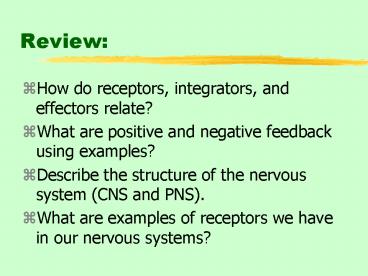Review: - PowerPoint PPT Presentation
1 / 30
Title:
Review:
Description:
What are positive and negative feedback using examples? ... Gamma amino butyric acid (GABA) Synaptic Integration. EPSP (excitatory) Depolarizing effect ... – PowerPoint PPT presentation
Number of Views:33
Avg rating:3.0/5.0
Title: Review:
1
Review
- How do receptors, integrators, and effectors
relate? - What are positive and negative feedback using
examples? - Describe the structure of the nervous system (CNS
and PNS). - What are examples of receptors we have in our
nervous systems?
2
Information Flow and the Neuron
- Starr/Taggarts
- Biology
- The Unity and Diversity of Life, 9e
- Chapter 34
3
Key Concepts
- Neurons are the basic excitable cells of a
nervous system. - With stimulation, the polarity of charge across
the membrane reverses from negatively charged
inside the cell to being positively charged. This
is the electrical basis of the action potential.
4
Key Concepts
- Information flow starts with action potentials,
which self propagate along the plasma membrane. - Chemical signals called neurotransmitters
released from a neuron stimulate or inhibit the
adjoining neuron, muscle cell, or gland cell. - Information flow depends on integration of
signals.
5
Types of Neurons
6
dendrites
INPUT ZONE
cell body
TRIGGER ZONE
axon
axon endings
CONDUCTING ZONE
OUPUT ZONE
Fig. 34.3, p. 576
7
Signal Transmission
CHEMICAL ACROSS SYNAPSE
NEW START
ELECTRICAL
START
ELECTRICAL
8
A Closer Look at Action Potentials
- Sequence of Events
- Resting Membrane Potential
- Stimulus
- Depolarization to threshold, all or nothing
- Repolarization
- At a synapse neurotransmitters act
9
Establishing Resting Membrane Potential
- Membrane of the neuron at rest is
- Negative inside, positive outside
- Membrane potential can be detected by electrodes
inside and outside the axon - Usually about 70 millivolts
- Established by the Na/K pump and other proteins
Fig. 34.5, p. 577
10
trigger zone
Fig. 34.4, p. 577
11
Triggering a Potential
- Sequence of Events
- Stimulus deforms plasma membrane
- Deforming changes ion balance
- Graded signal spreads to trigger zone
- Signal must be at or above threshold to trigger
action potential
12
Action Potential All-or-Nothing Spike
Triggered when threshold potential is
reached Always the same size
During action potential, inside of patch of
membrane becomes more positive then outside
13
Propagation of an Action Potential
- Sequence of Events
- Na channels open
- Na rushes inside the axon
- This action depolarizes that section of the cell
( inside/ - outside) - Triggers more depolarization! ( feedback)
NA
14
Propagation of an Action Potential
- Sequence of Events
- Triggers more depolarization! ( feedback)
- The wave of depolarization sweeps down the axon
NA
15
Propagation of an Action Potential
- Sequence of Events
- The action potential sweeps down the axon until
it reaches the synapse - Neurotransmitters must then bridge the gap
16
Recovery back to resting potential
- Sequence of Events
- Depolarization eventually causes Na channels to
shut - K channels open and K rushes out
- Na /K pump activates!
K
NA
17
Chemical Synapses
- Neurotransmitters
- Acetylcholine (ACh)
- Junctions
- Neuron - cell
- Neuron - neuron
- Neuron - muscle
- Neuron - gland
- Excitatory effect
- Inhibitory effect
18
A Closer Look at a Chemical Synapse
19
A Closer Look at a Chemical Synapse
- Sequence of Events
- Action potential reaches synapse
- Triggers Ca 2 gates, Ca 2 rushes
into cell - Vesicles fuse with outer membrane and release
neurotransmitters - They diffuse and dock with next neuron
- They are then broken down by enzymes
20
DMA (000 to complete)
- None due to assembly schedule.
- We need to begin IMMEDIATELY at the bell!
21
Review Questions
- What establishes resting membrane potential?
- What triggers an action potential?
- What causes a depolarization of an axon?
- What causes propagation of an action potential?
- What causes repolarization?
- What causes neurotransmitters to be released?
22
Reference Diagram
23
Reference Diagram
K
Na
24
A Closer Look at a Chemical Synapse
- Sequence of Events
- Action potential reaches synapse
- Triggers Ca 2 gates, Ca 2 rushes
into cell - Vesicles fuse with outer membrane and release
neurotransmitters - They diffuse and dock with next neuron
- They are then broken down by enzymes
25
Examples of Signals
- Neurotransmitters
- Acetylcholine (Ach)
- Norepinephrine (NE)
- Dopamine
- Gamma amino butyric acid (GABA)
26
Synaptic Integration
- EPSP (excitatory)
- Depolarizing effect
- IPSP (inhibitory)
- Hyperpolarizing effect
- Synaptic integration
- Excitatory or Inhibitory
- Acetylcholinesterase
- Breaks apart ACh
- ACh is removed from the synaptic cleft
27
Structure of a Nerve
28
The Myelin Sheath
29
Reflex Arcs
- Reflex - Automatic movement made in response to
stimulus - Simplest reflexes - Sensory neurons synapse
directly on motor neurons - Stretch reflex
- Most reflex pathways include interneurons
30
Next Topic
- The Endocrine System
- Function
- Structures
- Feedback loops































